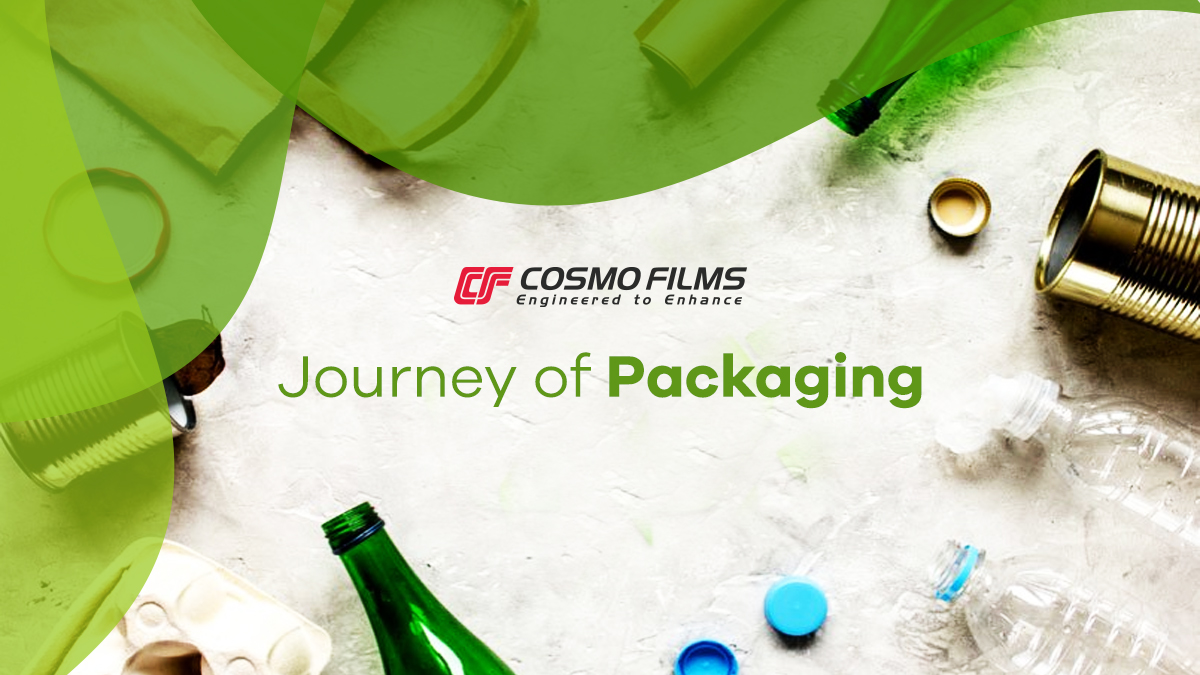Love to hear from you!
Get in touch.

Today, we use packaging everywhere—in the food & medicine industry, hospitality, transportation, and so on. This unimaginable amount of need & consumption for packaging is not new. From the oldest days to the present, packaging has always been an integral part of our lifestyle. However, its form & shape has drastically evolved over time to incorporate convenience & efficiency. Let’s explore the journey of packaging & how the present-day solutions are making a difference in our day-to-day commercial & domestic operations.
How It Came Into Existence?
The development of packaging in the early days owes to food storage requirements. Evidence can be found in the ancient Indian texts, for instance, Bhagvat Gita that talks about Sudama bringing food for his best friend Krishna packed in a cloth bag. From cloth to paper, wood & then glass, multiple forms of packaging came into existence, eventually. These underwent changes in form; from using flax fibers to wood pulp for papermaking.
Paper & Cardboard – Flexible Packaging
It is the earliest form of flexible packaging. However, this paper differed from the modern-day wood pulp paper. They made it using flax fibers and later old linen rugs. It wasn’t until the year 1867 that they started using wood pulp for making paper. Further advancements in the 1870s resulted in the gusset design and glued paper stacks, and at the turn of the century, the invention of machinery automated the production process.
Paper bags dominated the industry until the commercialization of cardboard box production in England and later corrugated papers for shipping cartons to replace wooden boxes & crates. Corrugated boxes were the first form of semi-flexible & high-strength packaging.
Another form that became popular was the paperboard packaging of Kellogg’s brothers. They were the first to introduce plastic in covering paperboard with a heat-sealed Waxite outer layer with their brand name printed on it. This trend became immensely popular in the 20th century until designers realized the environmental concerns.
Glass & Metals – Rigid Packaging
The earliest traces of glass-making are from 1500 B.C. in Egypt. It was made using four elements available in abundance in the area—sand, limestone, soda & silica. With time, the techniques of production got automated, resulting in mass production. At present, a machine can produce 20,000 glass bottles per day.
Metals in the earliest time were limited to gold & silver, however, soon stronger alloys and thin gauges/coatings (plating technique) were introduced as a cheap substitute. The plating technique replaced iron with steel to improve quality & output. It allowed food preservation for long periods without spoilage. With the advancement of technology, sealing, mass production & print for ads on metal cans became possible.
These rigid metal cans gave way to flexible packaging with soft metal tubes for storing artisan paints & toothpaste. Later they started using plastic packaging for the purpose.
Plastics
As the most recent & milestone innovation in the packaging industry, plastic revolutionized everything with its high strength & flexibility. Its use was first restricted to the military, and the application was brittle & sharp. Germany discovered its adaptability to multiple applications in 1933 with the production of foam that was widely used for cushioning & insulation.
Industry experts tried to explore the complete potential of this wonder material that led to its further development into Vinyl chloride, celluloid, Cellulose acetate, cellophane, polyethylene films, and Polyethylene Terephthalate (PET). Its most recent form widely used across the globe to achieve sustainability by reducing food wastage is BOPP films.
BOPP films are the latest form of flexible packaging; they can be modified to provide adequate barrier & heat resistant properties, boosting the shelf life of packaged products. It has now become an intrinsic part of the packaging industry and has adapted to environmental concerns as well by allowing reuse & recycle.
Conclusion
Plastic is an amazing material if used responsibly. It solves some of the main global challenges, like food spoilage by enhancing its shelf life. Cosmo Films, a reliable contributor in the packaging industry, has engineered a range of BOPP products that not only promotes recyclability but also reduces plastic consumption via structure rationalization. The organization has also developed a BOPP-based synthetic paper that serves as a replacement for conventional paper & is resistant to moisture, chemicals & oil, with an aim to bring down deforestation. Contact us to know more about Cosmo Films’ products.
Featured Post
Love to hear from you!
Get in touch.